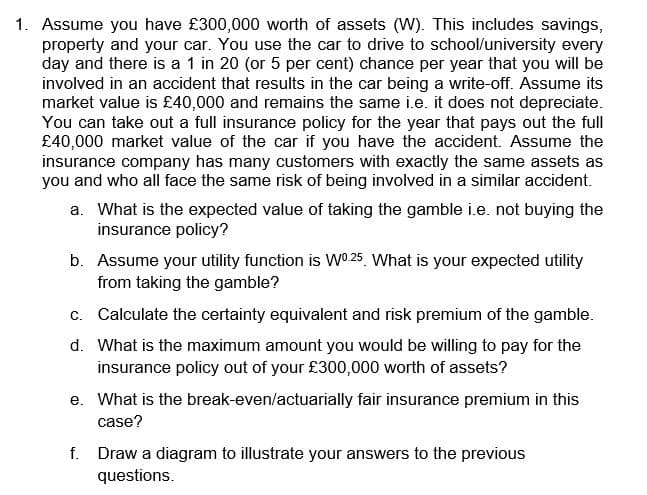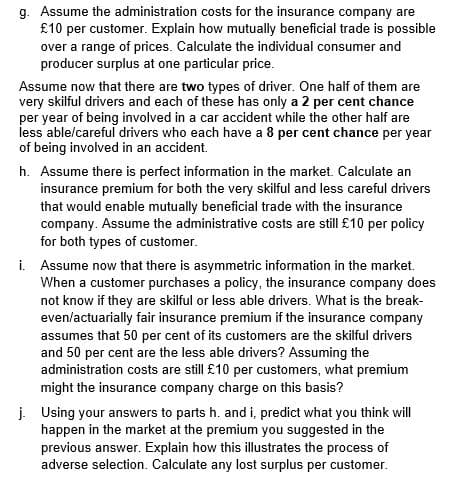1. Assume you have £300,000 worth of assets (W). This includes savings, property and your car. You use the car to drive to school/university every day and there is a 1 in 20 (or 5 per cent) chance per year that you will be involved in an accident that results in the car being a write-off. Assume its market value is £40,000 and remains the same i.e. it does not depreciate. You can take out a full insurance policy for the year that pays out the full £40,000 market value of the car if you have the accident. Assume the insurance company has many customers with exactly the same assets as you and who all face the same risk of being involved in a similar accident. a. What is the expected value of taking the gamble i.e. not buying the insurance policy? b. Assume your utility function is W0.25, What is your expected utility from taking the gamble? c. Calculate the certainty equivalent and risk premium of the gamble.
1. Assume you have £300,000 worth of assets (W). This includes savings, property and your car. You use the car to drive to school/university every day and there is a 1 in 20 (or 5 per cent) chance per year that you will be involved in an accident that results in the car being a write-off. Assume its market value is £40,000 and remains the same i.e. it does not depreciate. You can take out a full insurance policy for the year that pays out the full £40,000 market value of the car if you have the accident. Assume the insurance company has many customers with exactly the same assets as you and who all face the same risk of being involved in a similar accident. a. What is the expected value of taking the gamble i.e. not buying the insurance policy? b. Assume your utility function is W0.25, What is your expected utility from taking the gamble? c. Calculate the certainty equivalent and risk premium of the gamble.
Managerial Economics: Applications, Strategies and Tactics (MindTap Course List)
14th Edition
ISBN:9781305506381
Author:James R. McGuigan, R. Charles Moyer, Frederick H.deB. Harris
Publisher:James R. McGuigan, R. Charles Moyer, Frederick H.deB. Harris
Chapter13: best-practice Tactics: Game Theory
Section: Chapter Questions
Problem 14E
Related questions
Question
part A B C

Transcribed Image Text:1. Assume you have £300,000 worth of assets (W). This includes savings,
property and your car. You use the car to drive to school/university every
day and there is a 1 in 20 (or 5 per cent) chance per year that you will be
involved in an accident that results in the car being a write-off. Assume its
market value is £40,000 and remains the same i.e. it does not depreciate.
You can take out a full insurance policy for the year that pays out the full
£40,000 market value of the car if you have the accident. Assume the
insurance company has many customers with exactly the same assets as
you and who all face the same risk of being involved in a similar accident.
a. What is the expected value of taking the gamble i.e. not buying the
insurance policy?
b. Assume your utility function is W0.25 What is your expected utility
from taking the gamble?
c. Calculate the certainty equivalent and risk premium of the gamble.
d. What is the maximum amount you would be willing to pay for the
insurance policy out of your £300,000 worth of assets?
e. What is the break-even/actuarially fair insurance premium in this
case?
f. Draw a diagram to illustrate your answers to the previous
questions.

Transcribed Image Text:g. Assume the administration costs for the insurance company are
£10 per customer. Explain how mutually beneficial trade is possible
over a range of prices. Calculate the individual consumer and
producer surplus at one particular price.
Assume now that there are two types of driver. One half of them are
very skilful drivers and each of these has only a 2 per cent chance
per year of being involved in a car accident while the other half are
less able/careful drivers who each have a 8 per cent chance per year
of being involved in an accident.
h. Assume there is perfect information in the market. Calculate an
insurance premium for both the very skilful and less careful drivers
that would enable mutually beneficial trade with the insurance
company. Assume the administrative costs are still £10 per policy
for both types of customer.
i. Assume now that there is asymmetric information in the market.
When a customer purchases a policy, the insurance company does
not know if they are skilful or less able drivers. What is the break-
even/actuarially fair insurance premium if the insurance company
assumes that 50 per cent of its customers are the skilful drivers
and 50 per cent are the less able drivers? Assuming the
administration costs are still £10 per customers, what premium
might the insurance company charge on this basis?
j. Using your answers to parts h. and i, predict what you think will
happen in the market at the premium you suggested in the
previous answer. Explain how this illustrates the process of
adverse selection. Calculate any lost surplus per customer.
Expert Solution
This question has been solved!
Explore an expertly crafted, step-by-step solution for a thorough understanding of key concepts.
This is a popular solution!
Trending now
This is a popular solution!
Step by step
Solved in 5 steps

Knowledge Booster
Learn more about
Need a deep-dive on the concept behind this application? Look no further. Learn more about this topic, economics and related others by exploring similar questions and additional content below.Recommended textbooks for you

Managerial Economics: Applications, Strategies an…
Economics
ISBN:
9781305506381
Author:
James R. McGuigan, R. Charles Moyer, Frederick H.deB. Harris
Publisher:
Cengage Learning

Managerial Economics: Applications, Strategies an…
Economics
ISBN:
9781305506381
Author:
James R. McGuigan, R. Charles Moyer, Frederick H.deB. Harris
Publisher:
Cengage Learning